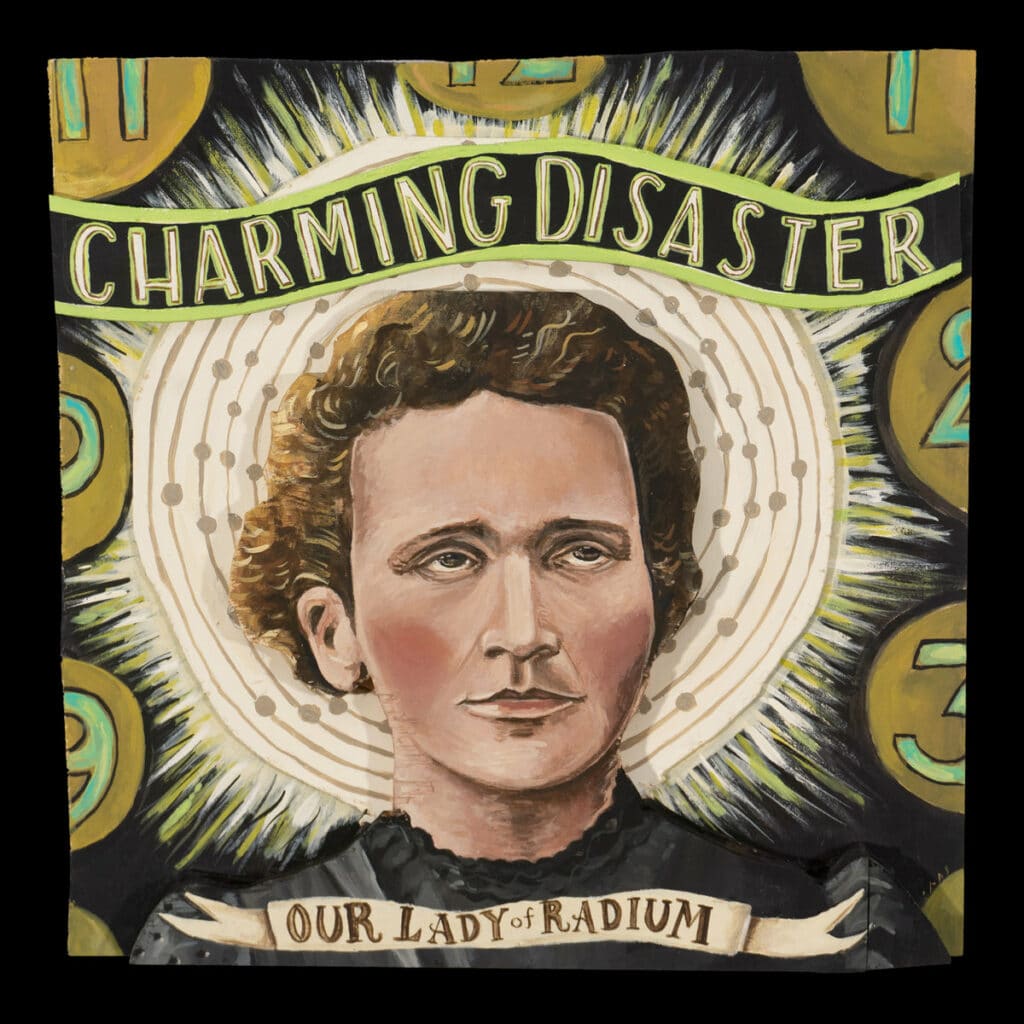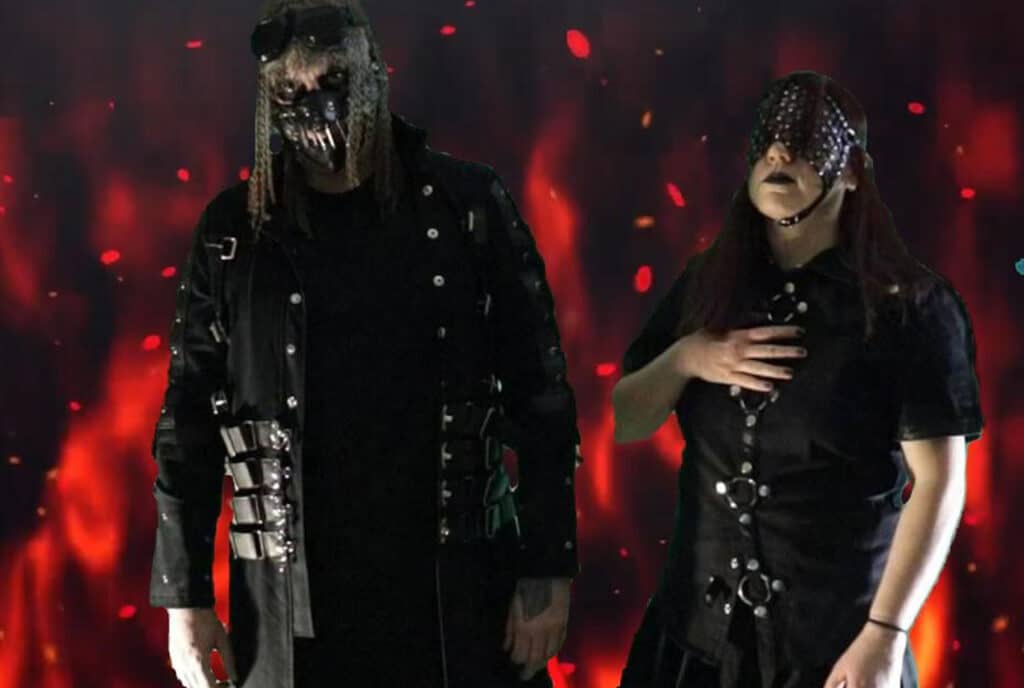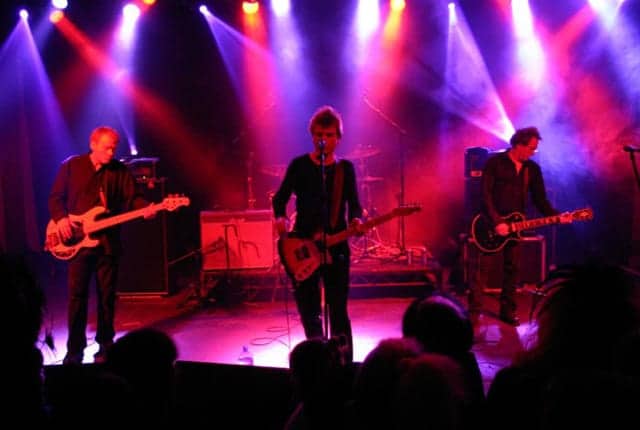On their latest album, Our Lady of Radium, goth-folk duo Charming Disaster explores the life and research of pioneering scientist Marie Curie. Marie did groundbreaking work in chemistry and physics with her husband Pierre, discovering elements polonium and radium and receiving a joint Nobel Prize. Pierre died tragically, while Marie’s further work earned her a second Nobel Prize. Charming Disaster found ‘mythological and poetic’ aspects to the story of Curie and made it fit perfectly with their musical aesthetic.
Based in Brooklyn, Charming Disaster consists of Ellia Bisker and Jeff Morris. Our Lady of Radium has its roots in a residency they did at Crosshatch Center for Art & Ecology in Bellaire, MI. Over a Zoom interview, they discussed the making of the album.
Could you discuss how you came to do an album based on this subject matter?
Ellia: We’ve been writing songs together since 2012. And typically, our songs tell stories where each song is its own universe. So one song is, you know, a couple of circus artists are in a complicated situation or on another a set of people in a…
Jeff: Someone’s killed somebody.
Ellia: Yeah. You know, just regular stuff. But we wanted to challenge ourselves with the idea of creating a suite of songs that all took on the same kind of narrative universe. We looked around for a while to figure out what story we wanted to engage with in that way. We tried a few things that weren’t successful. And we discovered this wonderful graphic novel called “Radioactive” by Lauren Redniss, which explores the life and times and discoveries of Marie Curie in this really interesting nonlinear way. So it’s not strictly like a biographical narrative. It talks about her relationship with Pierre, her husband and collaborator. It talks about the repercussions of her research, from radiotherapy in nuclear medicine to Chernobyl. And also, her life is full of drama, things like duels over a scandal that nearly wrecked her career. There’s all this mythological and poetic kind of content and resonance in her story that really spoke to us. We often like to approach folklore and mythology in our songwriting. And even during Marie Curie’s own time, people often would compare her to Pandora, or Prometheus, the sort of double-edged sword of knowledge. So there were a lot of avenues to approach this material from.
Jeff: It’s not necessarily the science that initially got us, well, me, excited about it. It was the kind of work and research that she did along with these kinds of mythological overtones, and the duels. And the fact that she and her husband visited a spirit medium. That kind of semi occult stuff that was going on at the time. That was kind of the gateway drug into the science of it.
Ellia: The research was at the time when spiritualism and things like spirit photography were very popular. There were so many new discoveries, all these things that seemed impossible that scientists and intellectuals were willing to consider as possibilities. And so you’d have people claiming to be able to speak with the dead and scientists would go in with cameras and try to photograph it. So the story itself, it has so much multiplicity to it, so many different layers. So that was our proposal at the artist residency. We would engage with this material and come out of the residency with a bunch of songs. And so we did a lot of reading and a lot of writing down of notes on index cards. We kind of let the themes of the songs emerge organically. After about a week of reading and looking at our cards, we organized them into stacks, and we were like, all right, well, we’ve got a stack of cards about the spirit medium. We’ve got a stack of cards about the tragic death of Pierre. We’ve got a stack of cards about her process and the laboratory.
Jeff: So we made these groupings and categorized them into rough ideas. And then we both took turns on like, ‘okay, I’m gonna take the tragic death of Marie Curie. What are you taking today?’
Ellia: ‘All right. I’ll take her laboratory process.’ And we would repair to different corners of the cabin where this residency took place. It was sort of an artists’ retreat, isolation, offered by the Crosshatch Center for Art and Culture in Northern Michigan. So remote and in the middle of winter. The power actually went out at one point because of the snow. And we had to make grilled cheese in the fireplace, in a cast iron pan.
Jeff: In the dark.
Ellia: So we would go to our separate corners, and we would each start a song, and it was very motivating. I’d be like, ‘I don’t have any ideas, but I can hear Jeff’s guitars going. Like he’s definitely got something happening.’
Jeff: It’s really motivating to have somebody else kind of egging you on, whether they know it or not.
Ellia: And then we would break for lunch. We would do a show and tell, and then continue building the songs together. So each of the songs on this record is a collaboration. Either one or the other of us would’ve started it, but we completed all the songs together.
Do you feel you were able to incorporate all of the interesting ideas that may have come out of the research, or did you pick and choose and determine what to utilize?
Jeff: Perhaps if it were a four-week residency, everything would’ve gotten in there. But there are a couple things that were very interesting, and we are excited about that [but] we didn’t have time to get in there. We felt like it was enough. We had a good representation of the things that excited us about it.
Ellia: There is a sort of phantom album of the songs we did not write. By way of example, this includes Curie’s invention of X-ray trucks, which she took with her daughter to the front in World War I to offer soldiers access to this new technology. There were lots of interesting details that we didn’t get to include, but most of our favorite bits we did.
Jeff: It’s not that they worked or not. It’s like, okay, we were just attracted to these things, and this is what we made. It’s not like we wrote a song and then afterwards we’re like, ‘Oh, this doesn’t fit in the scope of the album.’ Everything that excited us really made it there. And there are other things; it’s just a matter of time and scope.
Were there any other artists or albums that you drew inspiration from, perhaps in terms of using historical subject matter?
Jeff: I mean, besides the Lauren Redniss book itself, which itself is an art object — it’s got all these beautiful illustrations, and she uses this special kind of printing that uses some sort of radioactive materials or something.
Ellia: Phenotype. And I will say that in our songwriting, we are certainly as inspired by works of literature and visual art as we are by other music. But I would name two other projects that were really inspiring. One is PJ Harvey’s Let England Shake, which is such a gorgeous and brilliant concept album that also is not like a linear narrative, but takes on this really huge subject from all these different perspectives. And it hangs together as a kind of complete work without being like a musical theater kind of concept album. PJ Harvey’s a huge inspiration. We’re both huge fans of her. And I mean, she’s probably my number one fangirl artist. And Rasputina is another. We actually got to tour with Rasputina in the fall of 2019, which was fantastic. And the way that she weaves together historical research into these really emotional songs is so fantastic. “1816, The Year Without A Summer” is a great example of that kind of research.
So in terms of timing, I know you did the residency, then you did another album, and then you returned to this. Did you plan on doing this album at this point in time? Or was it specifically the lockdown opening up a window of time?
Jeff: We’d written these songs, and we’d created these demos while we were up there, and they sat dormant because we had another album that was releasing and we were touring. And then as the lockdown happened, we were like, ‘Okay, we have this time.’
Ellia: We had actually planned to record other songs in 2020. We were going to go into the studio with other musicians and record other songs that we had written. Our usual method, or our usual process, for a recording is that we accumulate songs over time. We don’t typically go into a studio and say, ‘We’re gonna write a batch of songs and record them and that’ll be the album.’ It’s like, ‘Oh, like we have like 10; it’s time for an album.’ Sometimes, we even record them in batches where we’re like, ‘Oh, like, let’s record these four.’ And then like, ‘Let’s record these, this next batch’, and then like, ‘We’ll mix them all at the same time so that they have a unity’. So writing nine songs for ‘Curie’ all at once was sort of an embarrassment of riches. We were like, ‘Oh no, now we have all these songs.’ And we already knew that we had another album coming out. So, they sat and they marinated for a long time. Then in 2020, when we had to cancel our plans to record songs that are now going to be on the next album, after Our Lady of Radium, we decided that we would try to just record ourselves. So we got a couple of really nice microphones. And when I say really nice, I mean like affordably really nice, like I know microphones are one of those things you can spend as much money as you want on. But we got a couple of nice microphones, and because of the pandemic my parents were not in their home. They have another house that they kind of fled to outside of the New York City area. So we went to their house, and we set up our microphones, and we layed all the tracks ourselves. We used a metronome so that we would be able to stack everything, but we had only two microphones, and we did the drums with just two microphones. We did all the vocals. We did guitars and instruments, even the ukeleles. There’s some pots and pans from my parents’ kitchen on a couple of the tracks. Glockenspiel. The piano in the living room. We got it tuned, the piano I learned how to play on when I was a kid.
So there’s something really personal about the album. Oh, and another record that kind of was inspiring at the time was Fiona Apple’s Fetch the Bolt Cutters, which she also recorded in her home and let breathe; like you can really hear the sounds of the house in that album. She didn’t try to clean it. Like it has an organic quality to it that really made us feel free to do that as well: to let some of the edges, some of the seams show a bit. And then we mixed it remotely with Don [Godwin], so that it would have some polish.

Was this the obvious way to make the album? Did you consider trying to work with other musicians remotely?
Jeff: We felt like it would be a good kind of organizing principle for us to just work with what we had. I think also you should make it part of the sound of it, the nature of how we wrote it. It was just us locked up in a house for two weeks. And, on the other side, it was almost like the mirror image of that. It was us locked up in the house, again, recording it, and working just with what we had. And that became the organizing principle. It’s like, ‘all right, there’s a piano here. We’re borrowing a drum set. We don’t play those instruments really. Those aren’t our main instruments’ and everything else we would just try to use to make the sound, along with the sound of the house.
Ellia: Yeah. It became an artistic limitation that was really useful. Which is not to say that we haven’t done just what you’ve described as well during the pandemic. We released a track called “Spooky Action” a few months ago. For that track, we reached out … we had our friend Patricia Santos, who’s a cellist, add cello tracks. And we had another friend put some ham radio on that. And we mixed that all in. So that is definitely a way that we also like to work, but for the Curie material, it just felt right to have it just be us, kind of like Marie and Pierre and their laboratory.
Jeff: It was definitely a laboratory feeling.
Are there any particular tracks that you feel may have changed or evolved either because of the time between writing and recording or perhaps due to the recording process?
Jeff: We wanted to have some connections with it, like between the songs. So in the background, you’ll hear like the chorus of the last song in the background on the first song, as like some ghostly background kind of pre-premonition of what’s going to happen. And almost every song has like a little bit of some other song mixed in, whether it’s in the background or the verse or the chorus, transposed to kind of match the key, or not.
Ellia: And that was something that definitely happened because we were able to let the songs breathe for so long. We sort of first explored that idea a couple of years ago. Like after the residency, after we had written the songs, but we weren’t really playing them out. We had a couple of concerts where we performed them. But we just weren’t sure exactly how we wanted to present them and having a lot of time to let them sit was really helpful. As Jeff was saying, each of the songs ended up lending to or borrowing from another song and it enriches the whole album, I think.
Jeff: In ways that we didn’t expect. And there’s a certain poignancy to like the beginning, you know, you hear the end in the beginning, or like the song about the love affair between Marie and Pierre. And there’s also like hints of the song where his death is described. So all these little things are kind of connected that you may or may not be aware of.
Ellia: As far as specific songs go, the song ‘Forces of Nature,’ which describes their kind of courtship and falling in love. It contains a piece of ‘Eat Drink Sleep’, which is the song describing her grief after his death. And likewise, ‘Eat Drink,Sleep’ contains a bit of ‘Forces of Nature,’ like a memory and a premonition. There’s a symmetry to it, as if all these moments are kind of happening at the same time.
Is there anything else that you’d like to add?
Ellia: We would love to mention that in addition to the album itself, which is coming out on digital platforms and vinyl and on CD, there’s a lyrics and art book that we’re releasing to accompany the album. We’re doing physical copies of the book, and on Bandcamp there’s also the PDF version, which comes with every download. And the lyrics book includes not just lyrics, but also original artwork by Susan Saas, who created the album cover art with all of our research notes. The like hundred index cards that we built our songs out of, we scanned them all and they’re all part of the layout of the book. So you can really see; we’re showing our work.
Purchase Our Lady of Radium from charmingdisaster.bandcamp.com. For more info, on Charming Disaster, visit charmingdisaster.com.










